In the world of guitars, the battle between Stratocaster vs Les Paul has been ongoing since their debuts in the 1950’s. It’s the guitar equivalent of The Beatles vs The Rolling Stones, and is a hot topic that every guitarist has an opinion on.
But, opinions aside, these two titans of guitar models are very different from each other – sometimes in ways that you might not expect.
As a guitarist for over 15 years, and an owner of both guitar models, I’ve put this article together to share the differences between the two – and importantly – what this means for you! Whether you’re researching for a new guitar or are just curious.
I’ve included facts, figures, and my own personal experiences to give a players perspective on the great Stratocaster vs Les Paul debate.
So, will you be team Stratocaster or team Les Paul? Let’s find out!
You can use the following links to jump to a particular section on this page:
- The key differences between a Stratocaster vs a Les Paul
- Sound comparison between a Stratocaster vs a Les Paul
- Which one’s right for you?
Affiliate disclaimer: This page contains affiliate links for products that I’ve tried and tested. As an Amazon Associate I earn from qualifying purchases at no additional cost to you. Learn more here.
The key differences between a Stratocaster vs a Les Paul
Quick Summary
Here’s a quick summary table of the differences between a Stratocaster vs a Les Paul. I’ll explain how each of these differences will affect you as a player throughout this article.
Please note: These differences are based on the “standard” models offered by Gibson and Fender, and are only for illustrative purposes.
| Feature | Les Paul | Stratocaster |
|---|---|---|
| Price (parent company)* | $1,299 – $2,999 | $849.99 – $2,499.99 |
| Price (subsidiary company)* | $499 – $649 | $199 – $459.99 |
| Weight | 8-10 lbs | 7-9 lbs |
| Pickup types | 2 x humbuckers | 3 x Single coil |
| Controls | 2 x volume, 2 x tone | 1 x volume, 2 x tone |
| Body design | Single cutaway | Double cutaway |
| Body material | Mahogany with maple top | Alder or swamp ash |
| Neck design | Set neck | Bolt-on neck |
| Fretboard radius | 12″ | 9.5″ |
| Scale length | 24.75″ | 25.5″ |
| Neck material | Mahogany | Maple |
| Bridge type | Tune-o-matic | Tremolo bridge |
| Headstock design | Angled, 3 tuners per side | All tuners on one side |
| Tuning pegs | Kluson or Grover | Fender |
| Pickguards | Easily removable | Mounts electronics to body |
| Output jack | Side mounted | Angled, front mounted |
1. Price
For most of us, price is often the biggest factor when deciding what to buy – and guitars can be a pricey purchase.
When comparing like-for-like models, the Gibson Les Paul is consistently more expensive than the Fender Stratocaster.
Generally speaking, this is because of the differences in the manufacturing process and materials used. The Les Paul guitars tend to use more expensive materials, and have a more labour-intensive construction process.
Let’s compare two similar models: the Gibson Les Paul Standard and the Fender American Performer Stratocaster. Both of these guitars the “standard” version of their models. Both are made in the USA.
The Gibson Les Paul standard costs $2,799 whereas the Fender American Performer Stratocaster costs $1,399. (Prices according to the manufacturers official websites, as at 22nd June 2022).
That’s a difference of $1,400. You could buy two of the Fender Stratocaster models for the price of the Gibson Les Paul.
So, if you’re on a tighter budget then a Fender Stratocaster may be the way to go…. or is it?
Both brands have budget options available, such as the “Gibson Les Paul Studio” and “Fender Player Stratocaster”. These “bare bones” models either have less design features (like the Les Paul Studio) or are made in a location where labour is cheaper (like the “Fender Player Stratocaster”).
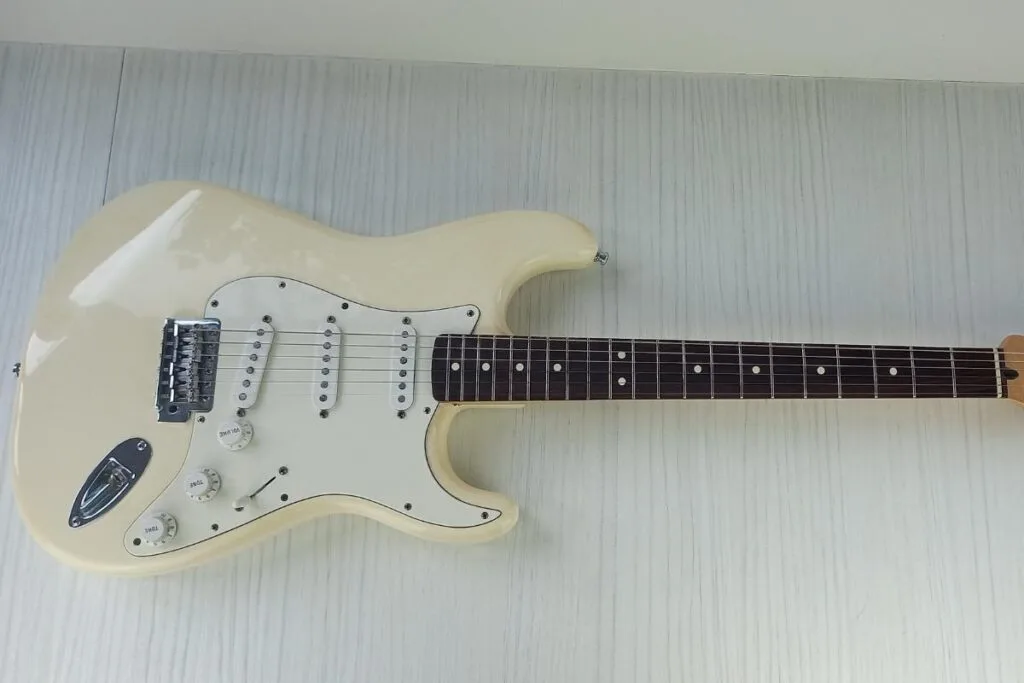
Not only this, but both companies have subsidiary companies that make even more affordable models. Fender has Fender Squire, and Gibson has Epiphone.
As you might expect, these are built in countries where labour is cheaper and use cheaper materials. However, they’re perfectly viable for beginners and intermediates alike.
Stratocaster vs Les Paul price comparison
I went to the website of both manufacturers and created the below table to show you the differences between the prices.
Please note: These prices are accurate as at 22nd June 2022 and may be subject to change.
| Guitar Model | Price ($USD)* |
|---|---|
| Gibson Les Paul Modern | $2,999 |
| Gibson Les Paul Standard | $2,799 |
| Gibson Les Paul Classic | $2,499 |
| Fender American Original ’50s Stratocaster | $2,249.99 |
| Fender American Ultra Stratocaster | $2,099 |
| Fender American Professional II | $1,699.99 |
| Gibson Les Paul Studio | $1,699 |
| Fender American Performer Stratocaster | $1,399.99 |
| Gibson Les Paul Tribute | $1,299 |
| Fender Vintera ’50s Stratocaster | $1,199.99 |
| Fender Player Stratocaster | $849.99 |
| Epiphone Les Paul Standard | $649 |
| Epiphone Les Paul Classic | $549 |
| Epiphone Les Paul Studio | $499 |
| Fender Squier Classic Vibe Stratocaster | $459.99 |
| Fender Squier Affinity Series Stratocaster | $289.99 |
| Fender Squier Bullet Stratocaster | $199 |
As you can see, the Les Paul models are consistently more expensive than their comparable Stratocaster models.
My opinion: I own both a Fender Mexican Standard Stratocaster and a USA built Fender American Standard Strat. I actually prefer the Mexican Stratocaster! It has a slightly different design that just works better for me.
It just goes to show: expensive doesn’t always mean better!
2. Weight
The weight of a guitar can affect its playability for some people. Heavier guitars require more strength and stamina to hold for longer periods of time, which can be a deciding factor if you want to play standing.
Les Paul’s have a reputation for being a heavy guitar, and are generally heavier than Stratocasters. This is because of the differences in wood that they use (more about that later!).
According to Fender’s official website, the Fender Stratocaster weighs between 7-9lbs.
Gibson doesn’t list any official weight for the Les Paul guitars, however, they have made efforts to reduce the weight of their guitars by strategically removing wood from the body from some of their models.
A 2018 poll on the “MyLesPaul” forum showed that the average weight of a Les Paul was between 8-10lbs.
My opinion: There’s only a couple of lbs of differences between the two, but it can add up! I prefer the lightweight of my Stratocaster – it’s a lot easier for me to use playing live.
If you’re concerned about having to play a heavier guitar standing up, I’d suggest purchasing a padded strap to ease the strain on your shoulder.
3. Pickup types
One of the biggest differences between these two (probably the biggest) is their pickups. The pickups are the heart of your guitar and are responsible for the overall sound.
Les Paul’s have two humbucker pickups and Stratocaster’s have three single coil pickups. Now, there are some variations on the pickup type, depending on the model of Les Paul or Stratocaster you buy – but I’ve based this article on the most common set up for both guitars.
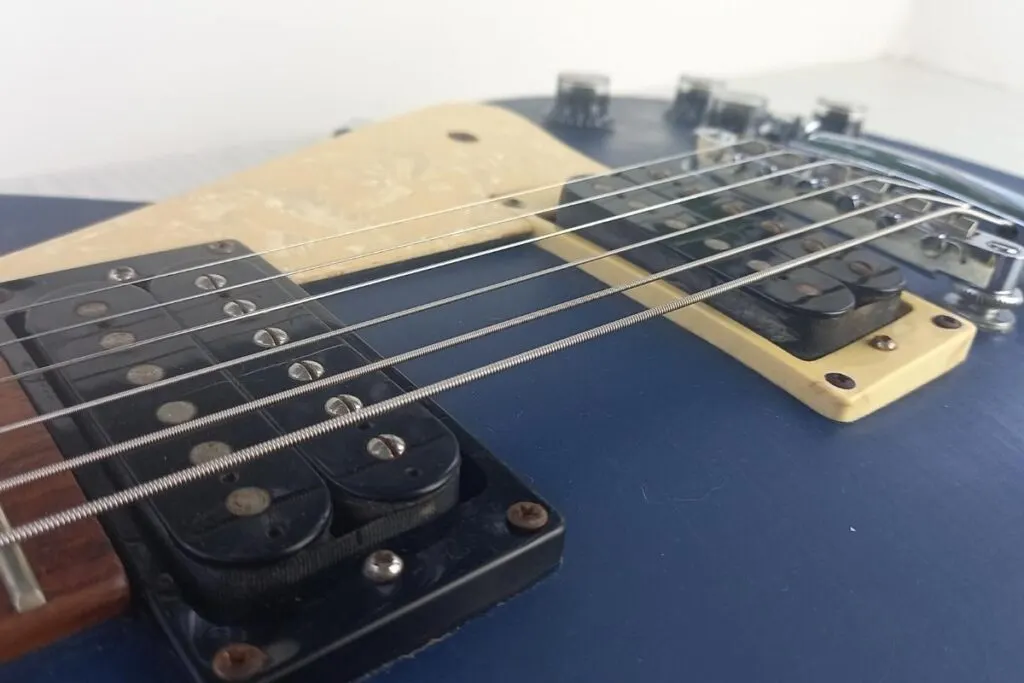
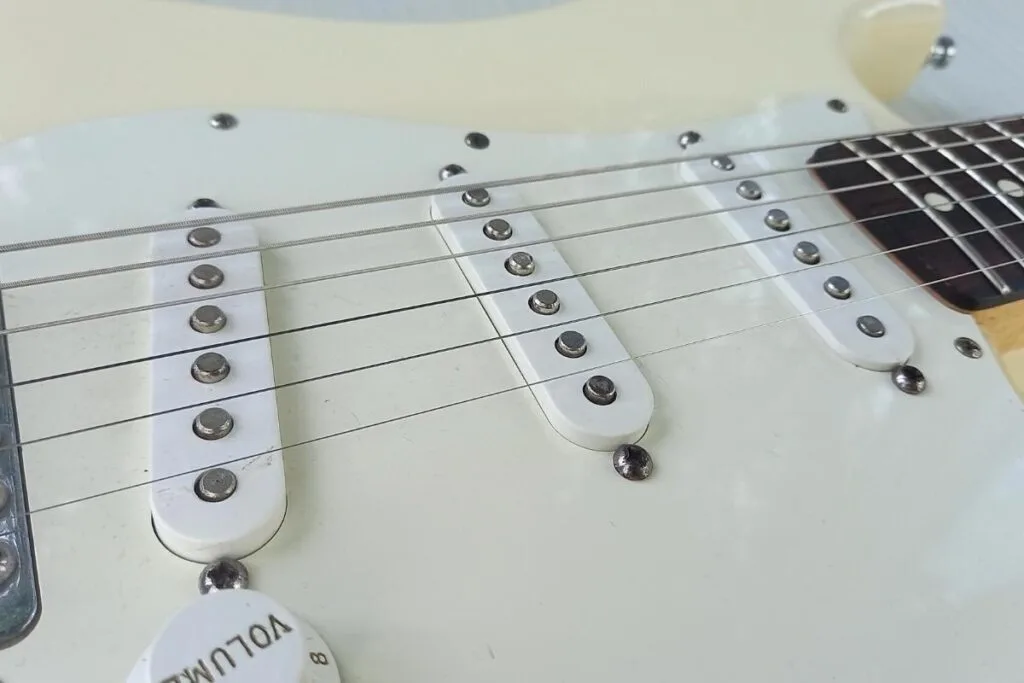
The single coil pickups on the Stratocaster make it sound bright, jangly, and great at cutting through a mix – but they do have a “humming” sound. The humbuckers sound warmer, fuller, and don’t have the “hum” associated with single coils – making them great for high gain signals.
I’ve written a full guide on the differences between single coils vs humbuckers that fully explains and demonstrates the difference in sounds between them.
If you’re looking for a brighter sound, or will be playing cleaner tones, then a Stratocaster might be for you. Likewise, if you want a full sounding guitar that can really drive a song, then you might want a Les Paul.
That being said – there are no rules when it comes to guitars. You can use either for any style – they just have their natural strengths!
My opinion: I’m a big fan of the versatility of the pickups on my Stratocaster, as it suits the styles of music that I play. That being said, the pickups on my Les Paul really pack a punch when I need them to.
It might help you to understand how pickups work to get a better understanding of which type you might want.
4. Controls
Having spoken about pickups, it only makes sense that I cover the differences between the controls on these guitars. The controls on a guitar let you change between the pickups, and are used to shape the volume and tone of your sound.
The Les Paul has a volume and tone knob for each pickup, and a three-way pickup selector. This means you can play using either the neck, bridge, or both pickups.
The Stratocaster has one master volume, and two tone knobs – one for the neck and one that’s shared for the middle and bridge pickup! Though, for some Stratocaster’s, this knob only controls the middle pickup.
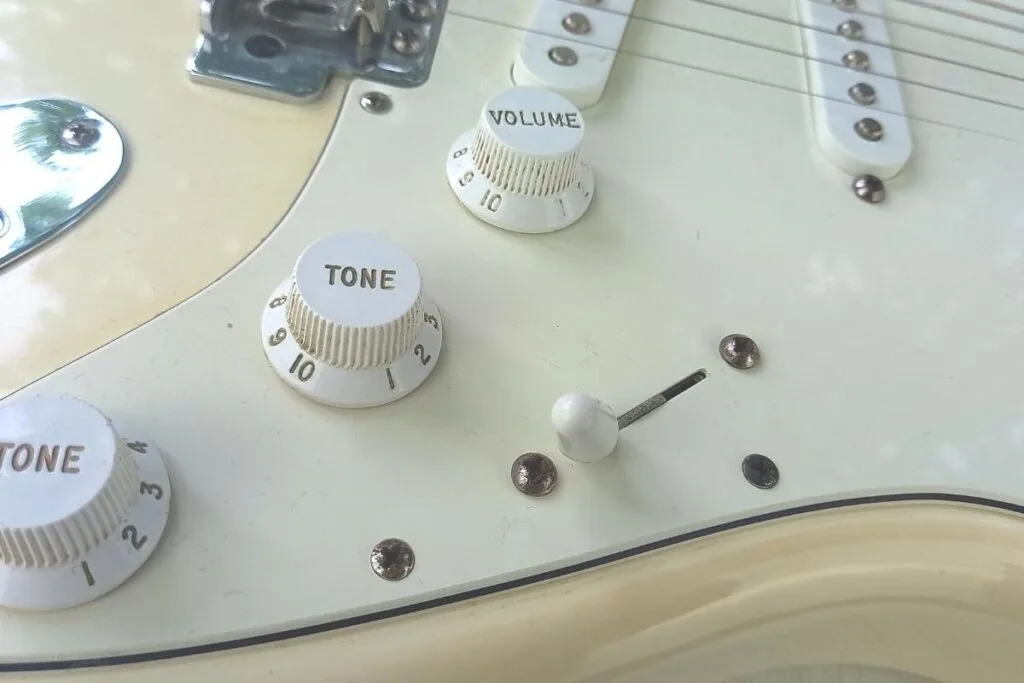
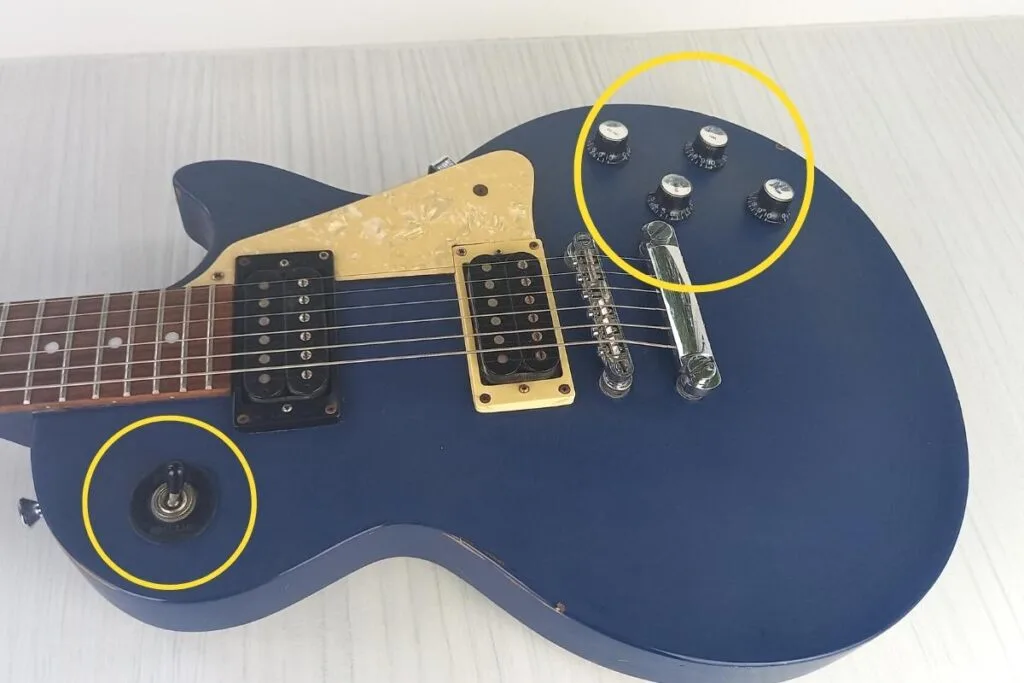
Though it lacks the knobs of the Les Paul – the Stratocaster makes up for it by having a five-way pickup selector. This means that you can select either the bridge, bridge and middle, middle, middle and neck, or neck pickups to play. This gives the Stratocaster a large amount of versatility in the sound.
The electronics on the Stratocaster are located under the pickguard, so everything is in one place – like lifting up the hood on a car!
The electronics on a Les Paul are a bit more spread out as they’re located in routed cavities on both the front and back of the guitar.
My opinion: I think the Stratocaster has a lot more versatility than the Les Paul in terms of tone – and it’s handy to have access to the electronics in one place (if you’re into that kind of thing!).
That being said, you can get a very wide array of tones out of a Les Paul – and being able to tinker with the electronics without having to remove the whole pickguard is very convenient!
5. Body design
These two guitars obviously look very different – but there’s more to their body shapes than just aesthetics. A guitar’s body shape can affect how easy and comfortable it is to play.
The Les Paul has a single cutaway, which can make it tricky to reach the higher frets, as your thumb is blocked by a chunk of wood.
The Stratocaster, on the other hand, has a double cutaway. With the wood gone; it’s a lot easier to reach the higher frets.
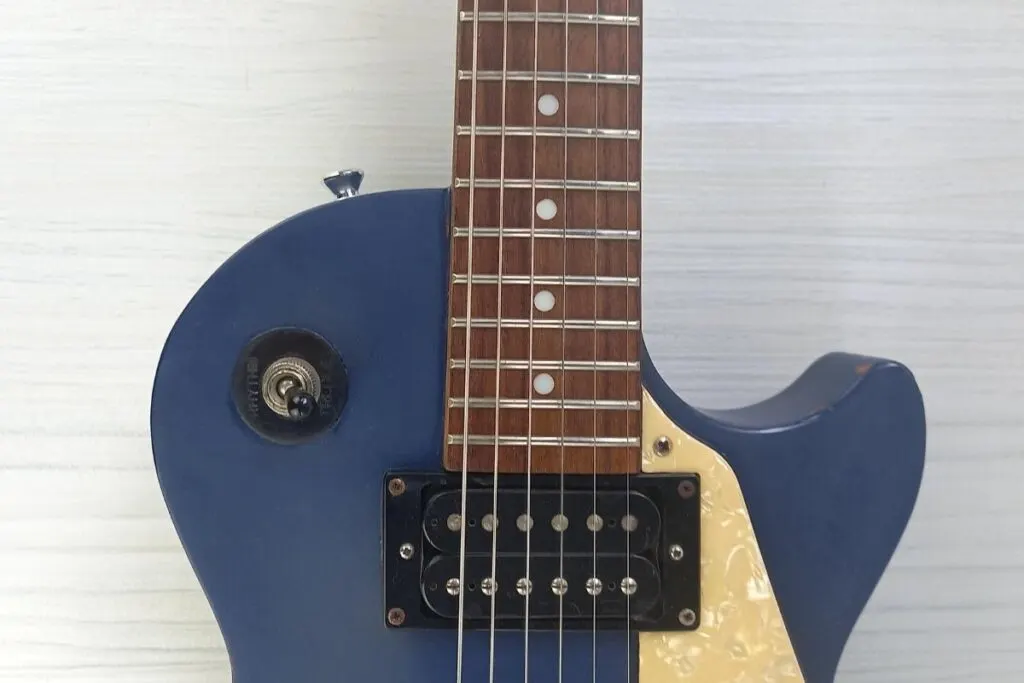
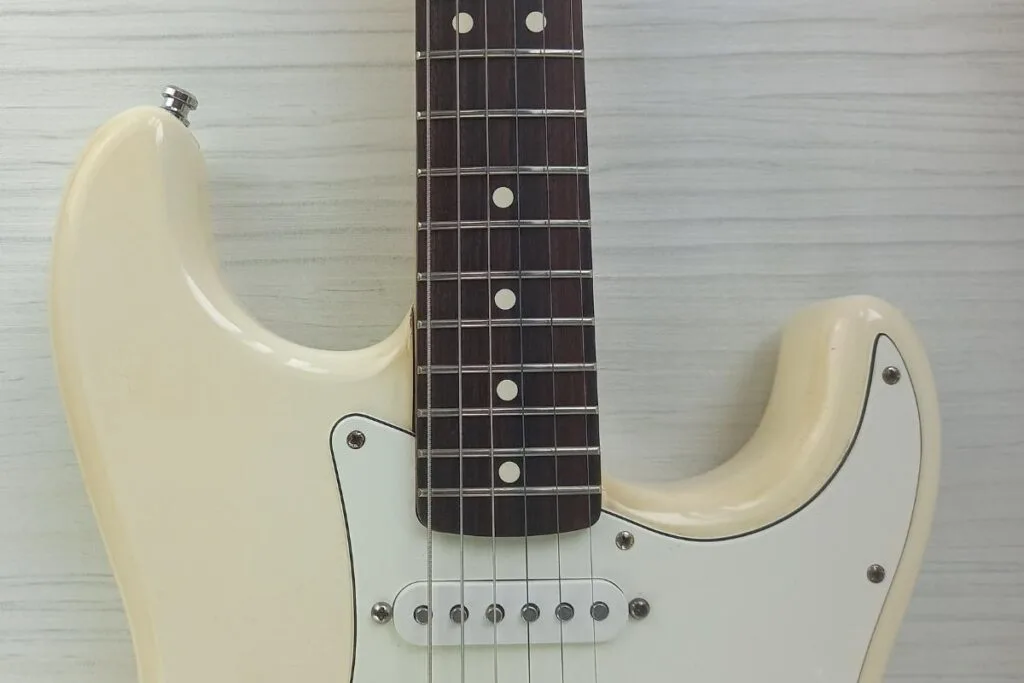
Not only this, but the Stratocaster has a contoured body with rounded edges which makes it more comfortable to play as it makes room for your arms and chest when sitting down. The Les Paul doesn’t have these contours, and so it can feel a bit blocky when playing.
The Les Paul is also slightly thicker overall, thanks to its arched top – which adds to its overall mass. The Stratocaster has a flat top and is thinner, partly due to the body contouring.
My opinion: I find the Stratocaster a lot easier to play from a comfort perspective. Having a rounded body makes more comfortable practice sessions. And, having easier access to the higher frets makes playing a lot more straightforward.
I don’t think that the Les Paul is uncomfortable – it just takes a little more getting used to than a Stratocaster.
6. Body material
The materials that a guitar is made from has a large affect on both its performance and aesthetics. These guitars both use different types of wood for the body
Stratocasters use alder or swamp ash wood for the bodies, whereas Les Pauls use Mahogany with a maple upper layer, called a “top” or “cap”.
These tops can also be aesthetic as well as practical, in the cases of flame or quilted maple tops. Les Paul’s with these tops often use a translucent paint to show through the wood grain. These guitars often also have “binding” – a thin trim of plastic that surrounds the body – to really tie the look together.
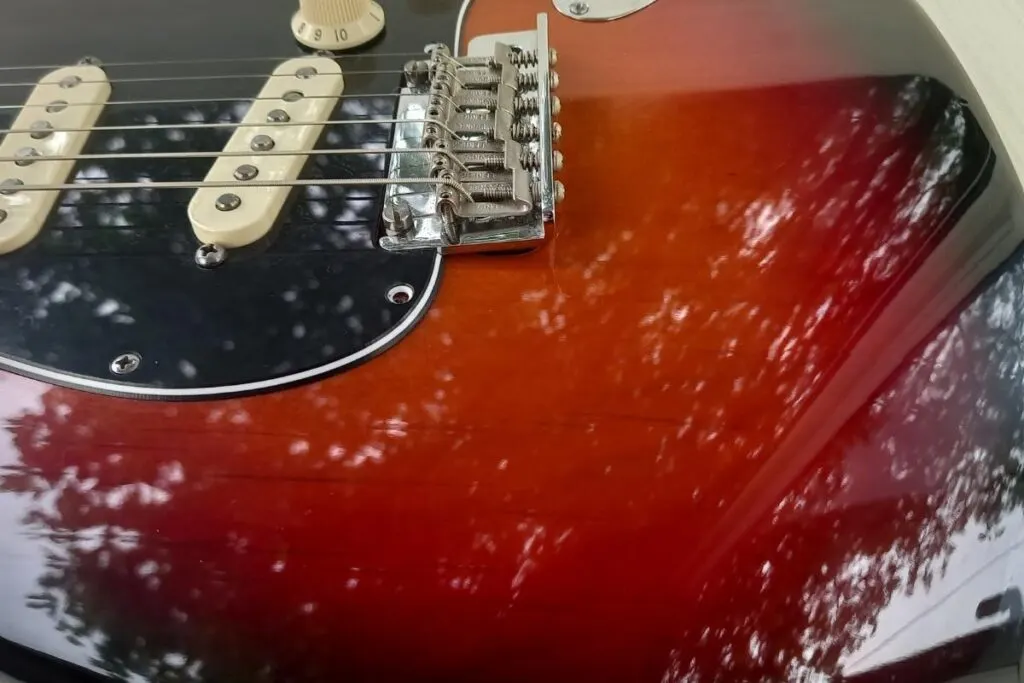
The type of wood used mostly affects the price and weight of the guitars – but also has an impact on the overall sound.
The wood choice can subtly brighten or darken the overall tone of the guitar. Generally speaking, closed-pore woods, like mahogany, are meant to increase the guitars sustain (how long the strings ring out for). This is because the strings are meant to reverberate through the guitars body, which continues to slightly vibrate the strings.
A guitar with a more open pore wood, like swamp ash, are meant to have less sustain overall but a brighter sound.
Now, there’s a lot of discussion online as to the degree that the wood impacts the sound – but I’m not going to go into that here! What I will say is that Les Paul’s are well known for their great sustain. Stratocasters have less sustain, but have a much brighter sound.
My opinion: Some Les Paul’s – especially those with flame or quilted maple tops – are exceptionally beautiful guitars. If you’re looking for something to wow and impress, then you can’t go wrong with one of these. Also, it’s true that these guitars have great sustain.
The body on my American Stratocaster has a partially exposed grain, which looks great – albeit less obvious. For me, the biggest impact of the body material is on the overall weight.
7. Neck design
When it comes to a Stratocaster vs Les Paul – one of the more meaningful differences is the necks.
Stratocasters use bolt-on necks, meaning that the neck is screwed on and can be removed. So – should a dreaded break occur – the neck is easy to replace. In contrast, Les Paul’s have a “set neck”, meaning that the neck is glued into the body. This means if it breaks – it’s going to cost you quite a bit of money to repair, and even more to replace it.
But, the neck being attached to the body is part of what gives the Les Paul its rich, warm tone and sustain as there’s a more resonant response between the neck, body, and strings.
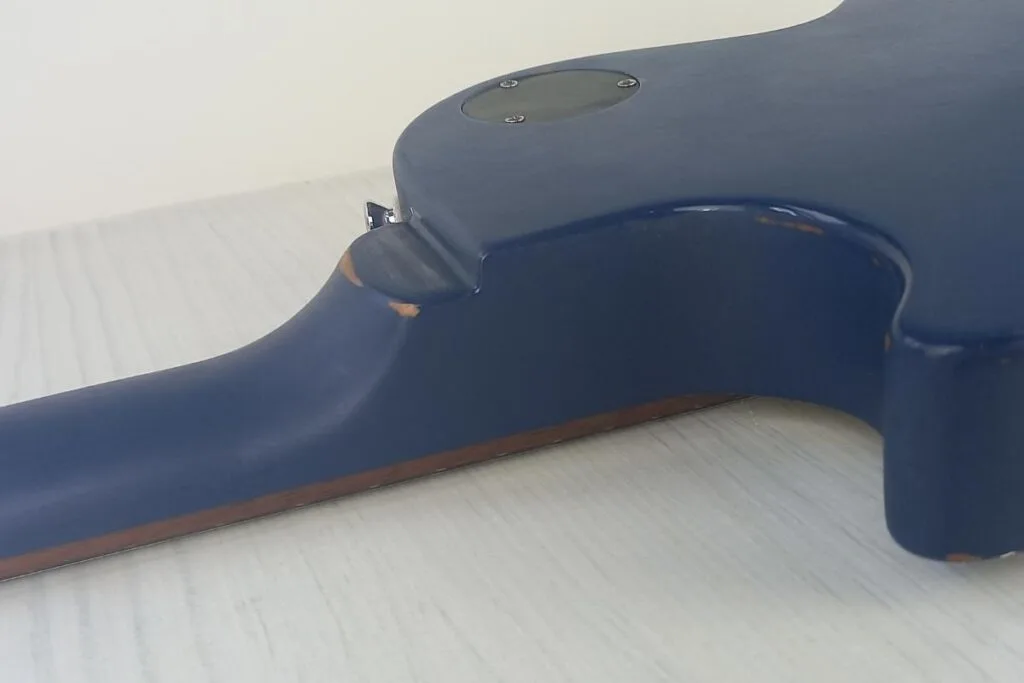
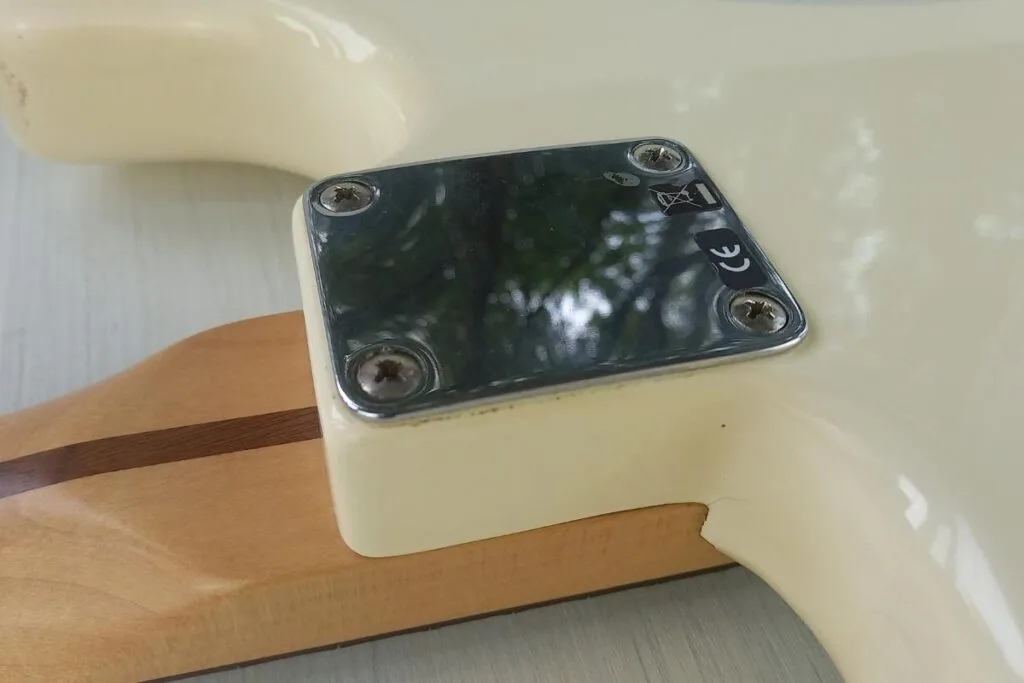
As for neck shapes, the Stratocaster tends to use a “C” shape neck, whereas the Les Paul uses a “U” shape neck. This means that the Les Paul neck is thicker than a Strat.
The final piece of the neck design puzzle is the “heel” of the neck: where the neck joins the body. The Stratocaster has quite a small heel whereas the Les Paul has quite a large heel. This larger heel can be a bit of a problem if you have smaller hands trying to reach the upper frets, especially considering the single cutaway design
My opinion: I prefer the neck on my Stratocaster – the neck shape feels better in my hand and the small heel makes it easier to reach the top frets. I also like knowing that if it broke, it won’t cost a lot of money to replace.
That being said, my Les Paul is perfectly playable, it just feels different. I’ve also not broken my Les Paul in the 15+ years that I’ve owned it – so as long as you’re careful, you’ll be fine!
8. Fretboard radius
Speaking of guitar necks and hand-feel, another important factor is a guitar’s fretboard radius. I wrote a full guide explaining fretboard radius (and why it matters). It’s essentially how flat or curved the fretboard is – a larger radius means a flatter fretboard.
Les Paul’s have a larger fretboard radius than a Stratocaster. Again, different models will have different radii – but a Les Paul will often have a flatter fretboard vs a Stratocaster.
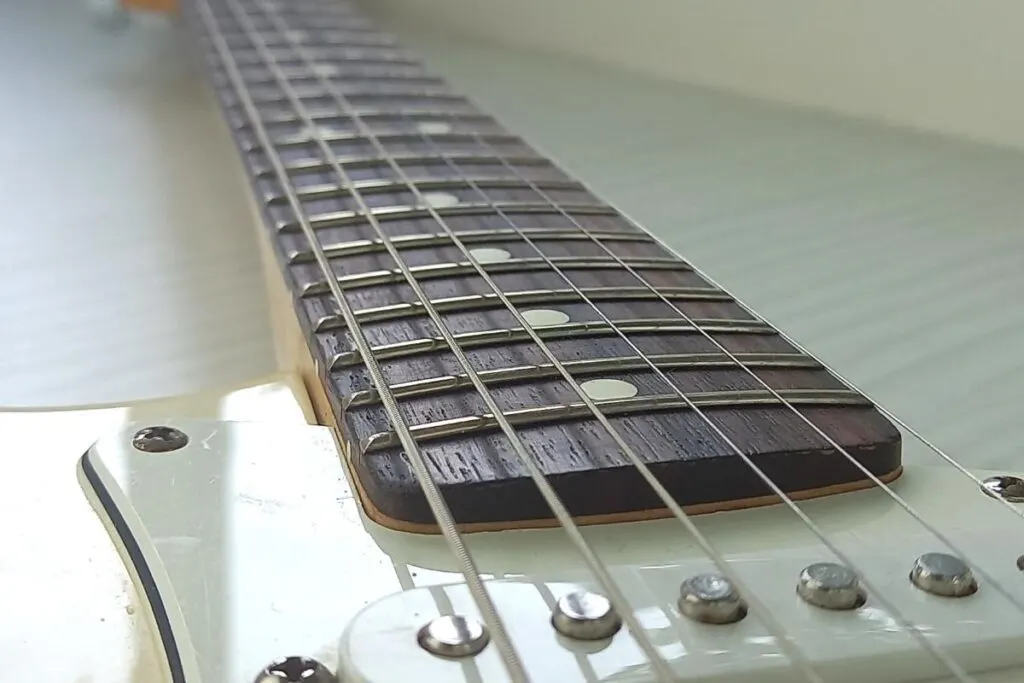
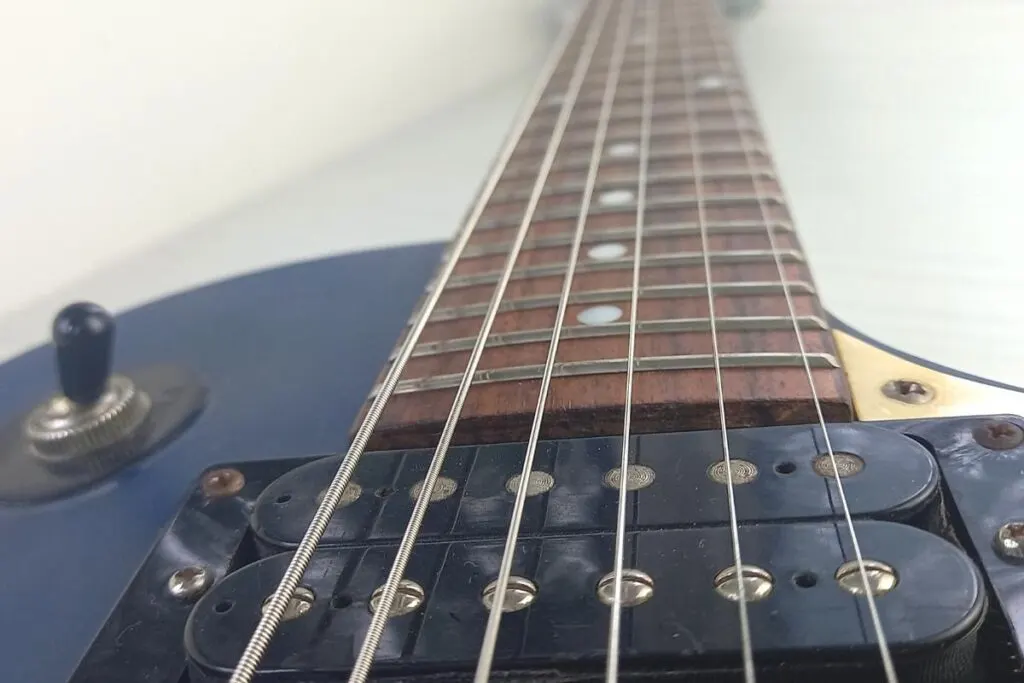
This has both benefits and drawbacks. On the good side, a flatter fretboard means that it’s both easier to fret strings and move between strings, and makes advanced techniques like sweep picking and string skipping easier.
That being said, a flatter fretboard doesn’t fit the natural contour of your hand as well, which can be harder for fretting chords lower on the neck. In some cases, this can make your hands tired or even give you hand strain. But, a proper warm up technique and practice will avoid that from happening.
My opinion: To me, fretboard radius is something that doesn’t matter too much – at least, it won’t be a make or break decision on which guitar to buy. I like the radius on both of my guitars, and don’t really notice it too much when swapping between them.
That being said – people can get quite passionate about fretboard radius – so I recommend seeing what feels most comfortable in your hands.
9. Scale length
Finishing off the theme of fretboard comfort – let’s take a look at the differences in scale length. This is the distance between the guitar’s nut and bridge.
A Les Paul has a shorter scale length vs a Stratocaster. A Les Paul’s scale length is 24.75” and a Stratocasters is 25.5”.
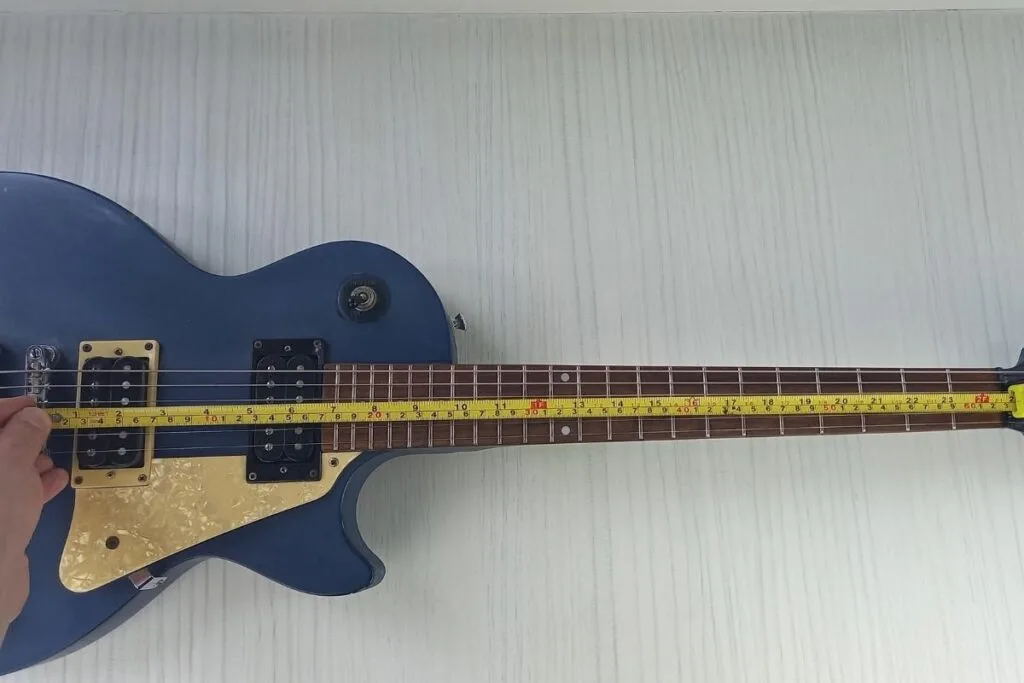
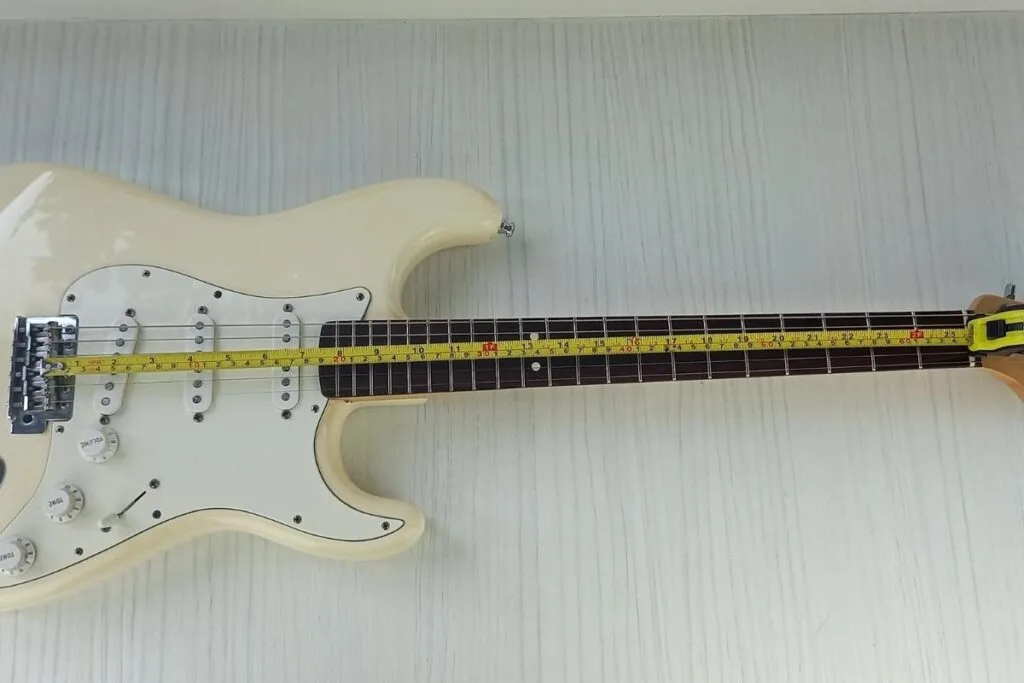
The biggest impact this has is on the spacing of the frets. The frets on a Les Paul are closer together, which may make it easier for beginners or players with smaller hands.
It also means that Les Paul’s have a lower string tension, making string bends easier compared to a Stratocaster using the same type of strings.
That being said, you can always go down a string gauge (thickness) to make bending easier.
My opinion: Like fretboard radius, I don’t worry about scale length too much. I don’t really notice a difference between my two guitars.
That being said, if you have smaller hands, then you might find the smaller scale length more comfortable to play.
10. Neck material
Like the body material, the materials used in the guitar’s neck helps to craft the overall sound. Stratocasters use maple wood for the guitar neck, whereas Les Paul’s have a mahogany neck.
Again, the mahogany neck is another factor that contributes to the warm tone of the Les Paul, whereas the maple neck of a Stratocaster make it brighter and snappier.
Both models historically used rosewood for the fretboard wood, however, Fender has moved towards Pau Ferro in recent years, as an initial response to conservation regulations that have since been lifted. Both types of guitar also have models that use ebony, walnut, or maple.
As for fretboard inlays, Stratocasters use dot inlays across all their models. Les Paul’s typically use more stylish “trapezoid” inlays, though dots are used on their no-frills studio models.
Most Les Paul necks also come with binding, which gives the neck a more refined look – again, this is just an aesthetic choice and is absent on the Studio models.
My opinion: Rosewood or Pau Ferro pretty much the standard for these types of guitars. Both of my guitars use rosewood fretboards, and I don’t notice the difference between them.
If you’re looking for something to stand out, then you can’t go wrong with a Les Paul neck with its binding and trapezoid inlays. (My Les Paul is a “Studio” model, so I don’t have any of these nice aesthetics!)
11. Bridge type
Depending on the sound you want from your guitar, the type of bridge the guitar has can be an important consideration.
Les Paul’s are a hardtail guitar, with a stop-bar tailpiece and a “Tune-o-matic” bridge. This means that the bridge doesn’t move. The hardtail bridge is also another piece that further increases the sustain and resonance of the Les Paul.
The Stratocaster, however, has a “tremolo bridge”. This incorrectly named bridge can pivot with the use of a “tremolo arm”, which raises or lowers the pitch of your strings and is used to make vibrato.
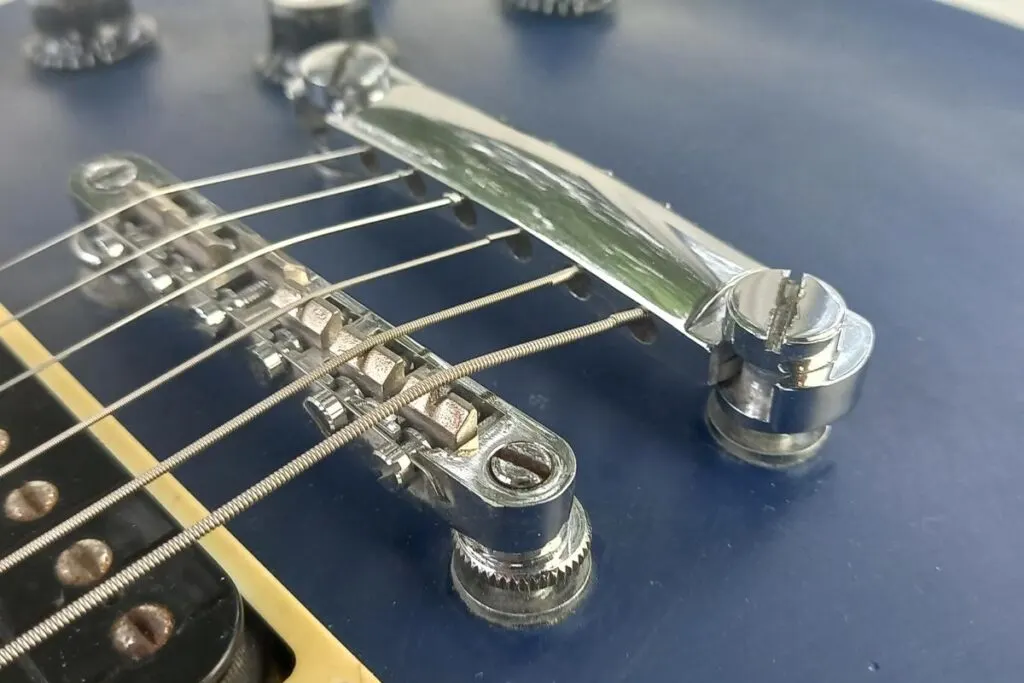
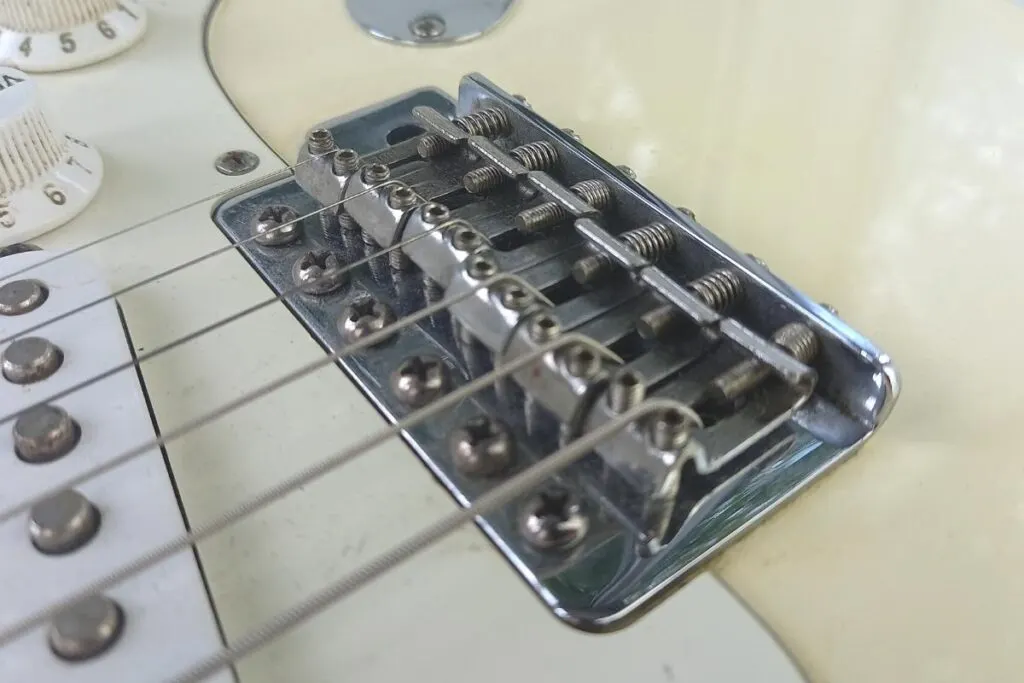
Using the vibrato system can mess with your string tuning in some cases, which means that a Les Paul generally has better tuning vs a Stratocaster.
In terms of raising and lowering the strings on your guitar (to make it easier to play or stop fret buzz) the Stratocaster bridge can adjust string heights individually. The Les Paul with its Tune-o-matic bridge, however, can only be raised or lowered at side of the bridge. This means that there’s less ability to fine-tune your guitars set up to your taste.
My opinion: I’m a fan of hardtail guitars, and I really like the Les Paul tailpiece and bridge. Even though I can’t adjust the string height individually – I can still adjust it enough for my taste, and I appreciate the extra tuning stability and resonance.
I’ve actually “decked” the vibrato system on my Stratocaster – meaning that it no longer moves. This gives some of the benefits of the hardtail, like the tuning stability, whilst also being able to adjust the individual string heights for my set up.
12. Headstock design
The headstock is the crown of the guitar. It’s a clear sign to the world of the guitars make and model – but it also affects their playability.
The Stratocaster headstock has all six tuning pegs on one side, as well as string trees to increase the “break angle” of the top four strings. The break angle improves the sustain and resonance of your guitar strings, by driving the vibrations into the guitar’s body.
There’s also open access to the truss-rod, which is used for adjusting a guitars neck relief.
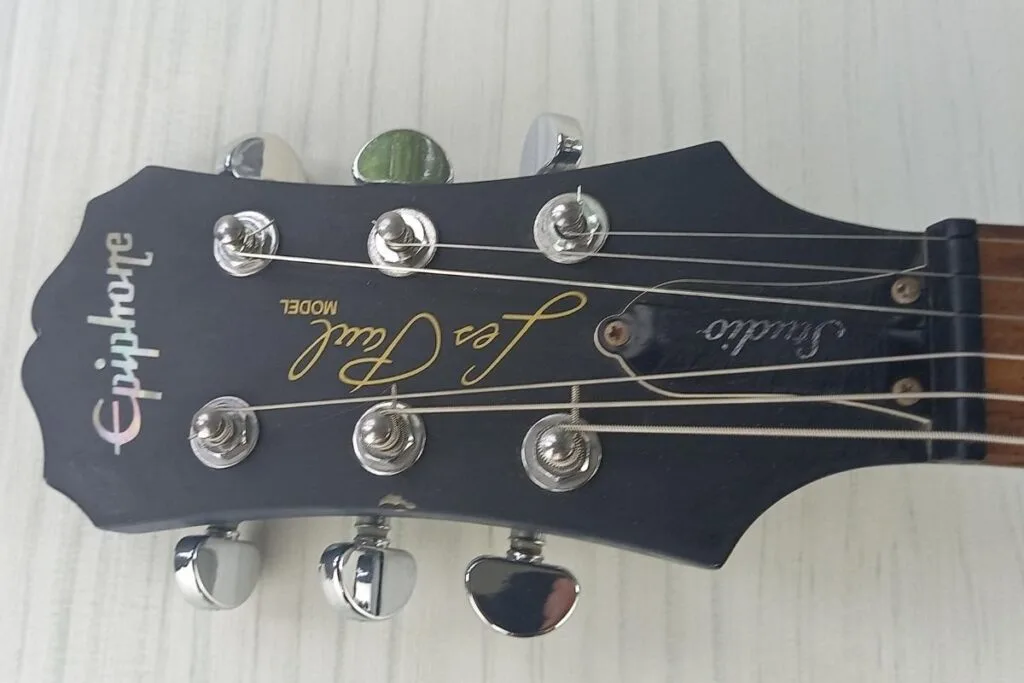
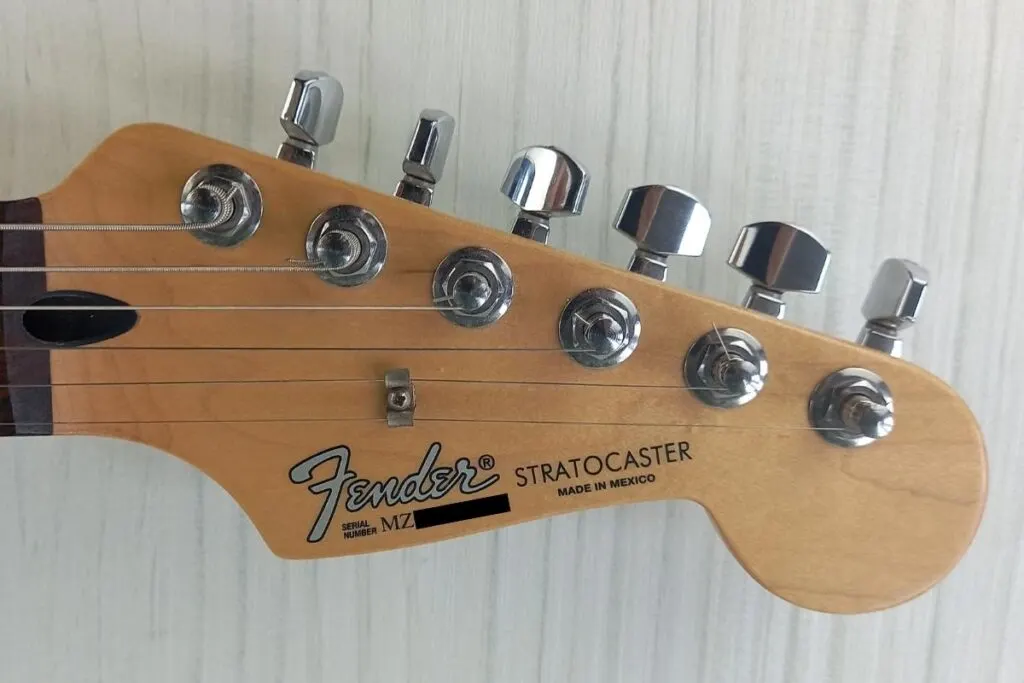
The Les Paul has a steeply angled headstock, which increases the break angle on all the strings. Like most other design features for the Les Paul, this feature contributes to its iconic resonance and sustain.
The tuning pegs are also split three on one side and three on the other.
The truss-rod on a Les Paul is protected by a small cover that needs removing if you need to make adjustments, which is slightly less convenient than the Stratocaster – but you’re not going to be needing to access it often.
My opinion: I really like the Les Paul headstock – the design and steeper angle really sets it up for increased sustain. That being said, I prefer the convenience of the Stratocaster headstock: all the tuning pegs are on the same side and there’s easy access to the truss-rod.
13. Tuning pegs
The tuning pegs (also called “machine heads”, or just “tuners”) are what keeps your strings tight and in tune.
The Les Paul uses a mix of Kluson and Grover tuning pegs, depending on the model. The Stratocaster uses Fender’s own tuning pegs, again with slightly different designs depending on the specific model.
There’s not much difference between the two other than style – so this is a matter of aesthetic preference!
Some models of these guitars offer “locking tuners”, which offer superior tuning stability – it might be something to consider investigating further if you’re looking to play live.
As I mentioned before, the position of the tuning pegs is the biggest difference with the Stratocaster having all the tuning pegs on one side of the headstock, vs the Les Paul having three pegs either side.
My opinion: I don’t really have an opinion on tuning pegs. I think the vintage style Kluson tuning pegs used on a Les Paul look very cool, but at the end of the day, all my experiences with standard tuning pegs have been about the same!
14. Pickguards
A guitars pickguard protects the guitar’s body from potential scratches from a guitar pick. Both of these guitars have different styles of pickguards – and they each have slightly different functions.
The pickguard on a Les Paul mounts to the guitar body using a small bracket. This means the pickguard can easily be swapped or even removed completely if you want!
The Stratocaster pickguard has a more important function, as it holds all the electronics in place. This means that you have to have a pickguard on your Stratocaster, otherwise there’s nothing to hold the electronics in place!
This also means that accessing the electronics means taking the pickguard off, which can be frustrating at times. It’s good to have everything in one place, but it can be frustrating if you just need to make a quick fix!
My opinion: I prefer the Les Paul pickguard in terms of its ease to swap out or just remove. It’s also good that it doesn’t hold the electronics in place, so the electronics are accessible from other points on the guitar.
You won’t need access to your guitar’s inner electronics too often, so feel free to disregard this point if you’re not interested in modifying your guitar!
15. Output jack
Last but not least is the guitars output jack, where the guitar lead plugs into. It’s a minor difference between the two guitars, but one to be aware of if you intend to play live.
The Les Paul has the output jack on the side of the body, meaning that the guitar cable plugs into the side of the guitar.
The Stratocaster, however, has an angled jack on the front of the body – meaning that the cable plugs into the front of the guitar.
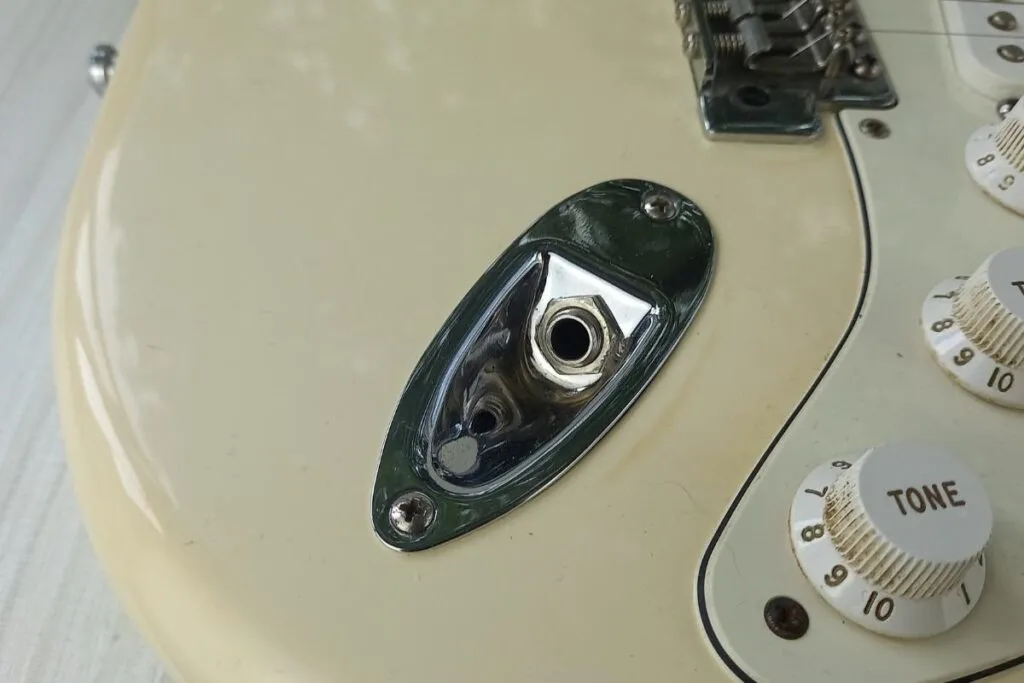
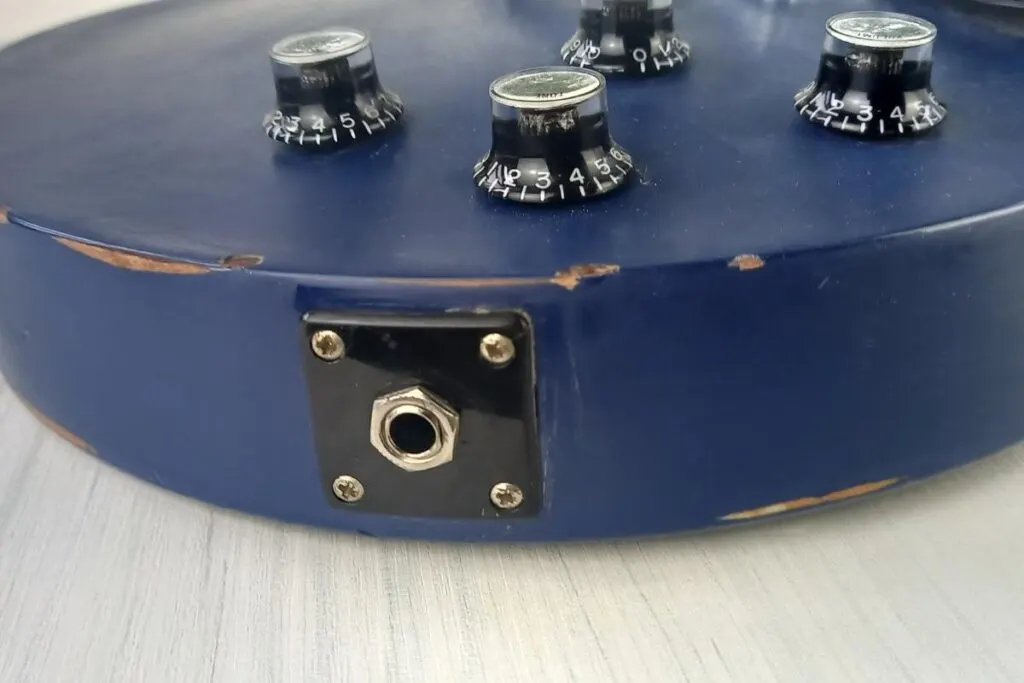
Having the guitar cable on the side of the body can make it easier for cable management when playing live. It’s also less likely to be accidently pulled out (from my experience!)
My opinion: This is solely down to preference.
Personally, I prefer the jack being on the side of the body as it’s further out of the way, and there’s less risk of pulling it out accidently.
Sound comparison between a Stratocaster vs a Les Paul
The sound of a Stratocaster vs a Les Paul is determined mostly from the guitar’s pickups type. Les Paul’s tend to come with two humbuckers, whereas Stratocasters tend to come with three single coil pickups – though there are models with different set ups.
So, comparing the sound of a Les Paul with a Stratocaster is really comparing single coil pickups with humbuckers.
Generally speaking, a Stratocaster sounds brighter and thinner than a Les Paul, which has a warm and thick tone. Whilst this is mostly down to the pickups, their construction material and design plays a part in this too.
Personally, I’m really liking the sound of my Stratocaster at the moment – as it sounds like it has more detail to me, and works great through both a clean and distorted signal. The Les Paul can sound a bit flatter, and a bit muddier at times – but I really love their warmth and fuller sound. They’re also a lot better at handling high gain signals.
Single pickup guitars, like most Stratocasters, have a loud pickup hum, which gets worse at higher gain and volume settings. Humbuckers greatly reduce this hum (hence the name) which makes them a great choice for hard rock or metal guitarists.
Let’s check out some examples of how they sound.
Les Paul clean
Stratocaster clean
Les Paul rhythm
Stratocaster rhythm
Les Paul lead
Stratocaster lead
Stratocaster vs Les Paul – which one’s right for you?
So, now that you know the differences between a Stratocaster vs a Les Paul, I’ve answered some additional questions that you may have.
Which is best for a beginner?
A Stratocaster has easier access to higher frets, a slimmer neck profile, and a smaller fretboard radius meaning that the fretboard is more comfortable for chords and other fundamentals that beginners will learn.
It’s also lighter weight and has a contoured body, which feels more comfortable to play during longer practice sessions. It’s also versatile for both clean and distorted tones, and sound great in both.
They’re also generally cheaper, meaning that you can get started with a good quality guitar without sinking a lot of money initially.
This doesn’t mean that Les Paul’s aren’t suitable for beginners though – in fact, I learned to play on an Epiphone Les Paul. It’s more that the Stratocaster ticks more boxes for being better for beginners.
But, if you (or the person you’re buying for) has their heart set on a Les Paul style guitar – then go for it.
The larger fretboard radius will make fretting individual notes higher on the fretboard easier. Likewise, the shorter scale length means that frets are closer together, which can be easier on smaller hands.
For beginners, I’d recommend picking up either an Epiphone or Squier model to start with. They’re great quality instruments and a lot more affordable than the main line Gibson and Fender models. You can then pick up a Gibson or Fender once you’re sure that playing guitar is for you.
So, if you don’t have a preference – I’d say pick up a Stratocaster. If you have a model in mind, then follow your heart and pick something you’ll be excited to play!
Which is easier to play?
Both guitars feel very different to play.
Les Paul has a larger fretboard radius which means that it’s flatter. This can be easier for solos and playing higher notes, but can make playing chords on the lower frets harder.
The Les Paul also has a smaller scale length, meaning that the frets are closer together which makes it easier to fret notes for smaller hands. Likewise, the smaller scale length means that there’s more “give” to the strings, making them easier to bend.
The Stratocaster has more curvature on the neck, which feels more ergonomic when playing chords – some people find it tricky playing higher notes because of the curvature. Personally, I think that you learn the instrument you have. I grew up learning on a Les Paul and eventually transitioned to Stratocasters. It wasn’t a hard process to switch, it just took a little getting used to, and now I’m able to switch between the two effortlessly.
The Les Paul is heavier than the Stratocaster which means that it can take its toll on you if you’re playing standing for long periods.
Also, the body shape of the Les Paul is more “blocky” than the Strat. The Stratocaster body is contoured which makes it more comfortable to sit and play.
So, to answer this question: I’d say that a Stratocaster is generally easier to play vs a Les Paul.
What types of music are they used for?
The Stratocaster and Les Paul are each better suited to certain styles of music – but that doesn’t mean you can’t use them to play other genres. I’ll give some broad advice, but remember – there are no rules when it comes to music! Play whatever you want with whatever you want.
Stratocaster
Stratocasters have a naturally jangly and clean sound thanks to their single coil pickups, which makes them a great choice for clean tones. But they also sound great through overdrive and distortion.
Remember though, the more gain you add in your signal chain, the more hum you’ll get from single coil pickups. This means that they’re not best suited for heavier genres like high-gain rock and metal – unless you pickup a Stratocaster with a humbucker pickup!
Les Paul
Les Paul’s are known for being the powerhouse guitar behind rock and blues. It’s a well earned position. The humbuckers can handle high gain signals without succumbing to humming, which makes them great for any rock and metal.
However, they can sound a bit flat when it comes to clean signals though. So, they may not be the best choice for country or certain styles of pop that require a “jangly” tone.
Final thoughts
So, now you know all the differences between a Stratocaster and a Les Paul. Hopefully, you’ll now have a better idea of which one you want to pick up.
If you’re still stuck on which one is for you, then I recommend going to your local guitar shop and trying both of them out.
Personally, my preference (at the moment) is a Stratocaster. They play great, they’re easy to fix and replace parts, and they’re very versatile in sounds. That being said, I love my Les Paul too – it’s great at what it does.
Ultimately, pick the guitar that excites you.
I remember being completely obsessed with Les Paul’s when I was younger (thanks to Slash) which inspired my choice to get an Epiphone Les Paul. This made me excited to play every day. It’s what I credit with keeping me going with learning and practicing.


Conor is a music producer, multi-instrumentalist, and all-round enthusiast from the UK with over 15 years of experience. He’s the founder and sole-content creator for the roundtable audio blog and YouTube channel.
